8 Gems on Facebook Marketplace
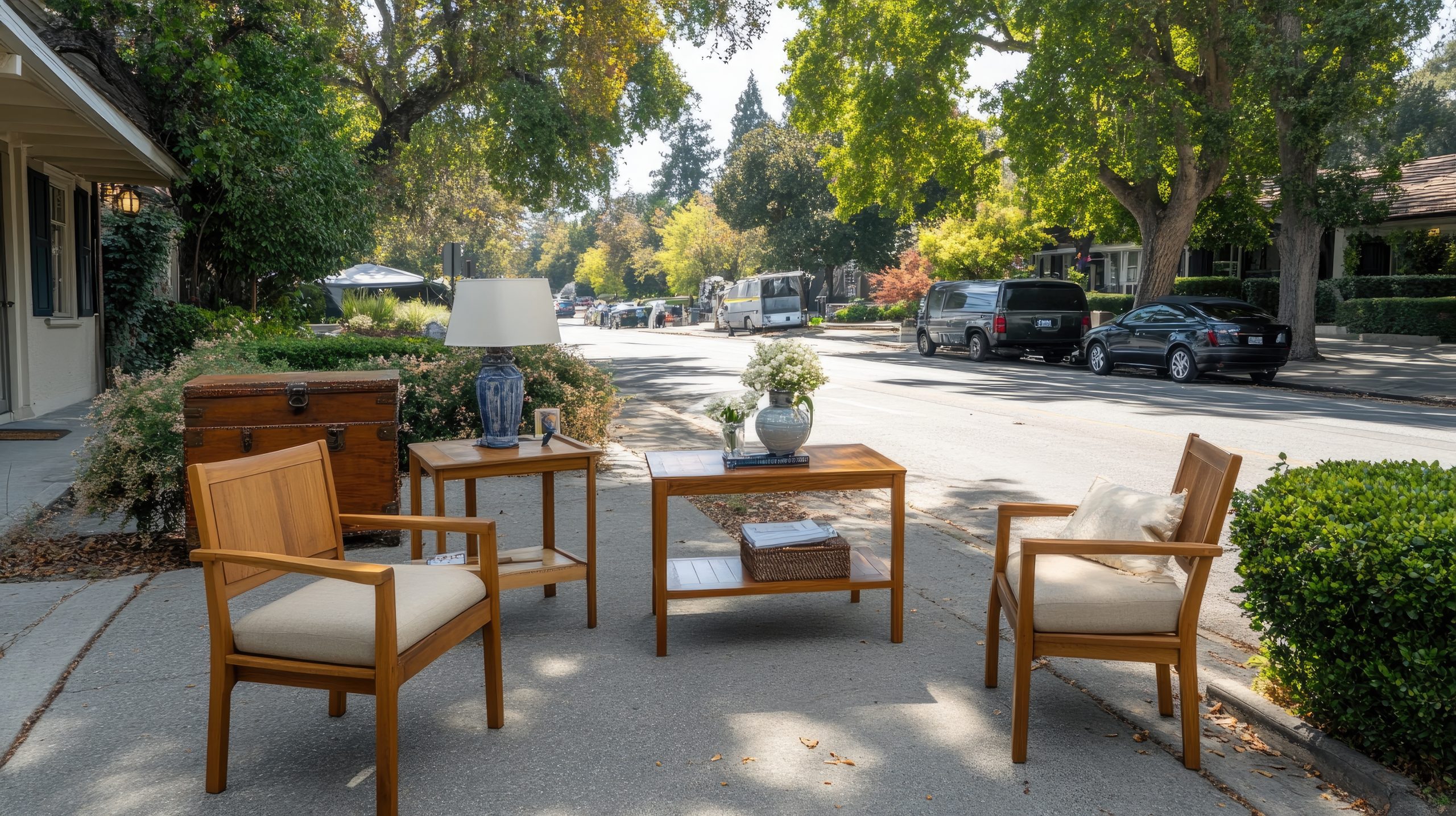
Facebook Marketplace is one of my favorite resources for furnishing and decorating my own apartment. I scroll through listings countless times per day and have lost track of how many pieces I’ve sourced from there over the years—probably 100, if not more! If you’re new to shopping on FBMP or just need a little inspo as you browse, keep reading to scope out eight of my favorite items currently listed within the DC area. Remember, Facebook Marketplace transactions can move pretty fast, so if you see something you can’t live without, it’s important to message the seller immediately!
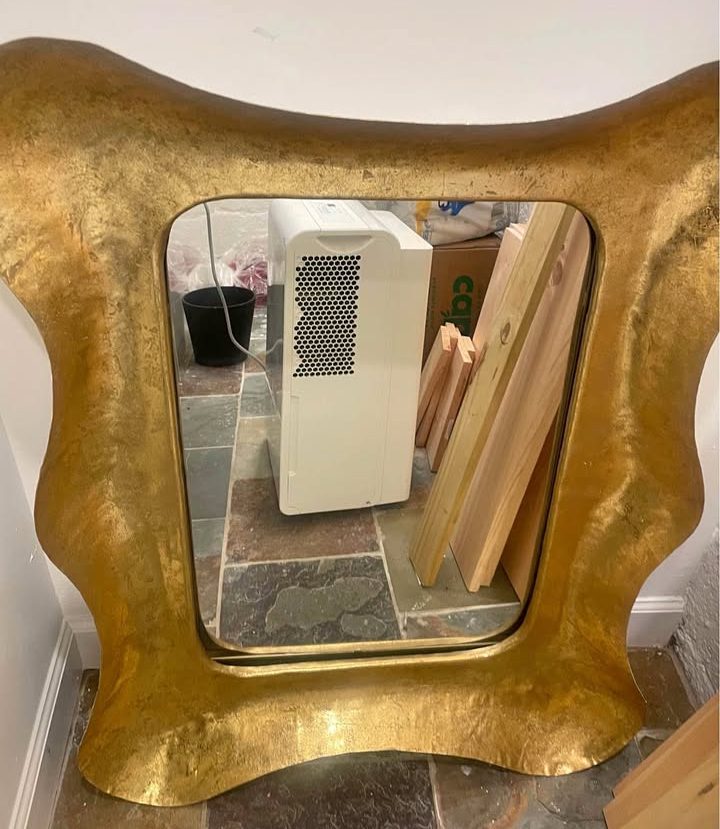
This gorgeous gold mirror is a prime example of an instance when you’ll want to look past an item’s listing photos and think about just how beautiful it could be when styled in the right place. Sure, the snaps shown here are pretty basic, but trust me, this mirror has tons of potential. I envision it hanging over a console table in the entryway or above a bedroom dresser. But that’s not all—it would also look lovely over the sink in a powder bathroom (I’m imagining it paired with some fun, bold wallpaper!).

Anyone who knows me knows that I go wild for any funky type of female portrait—and this one definitely checks many of my boxes. It’s bold, oversized, and vintage (the listing says it dates back to 1955). Use it to add some much needed color to any room of your home. Whether you hang it alone or style it with other pieces as part of a gallery wall, it is most definitely going to be an instant conversation starter.
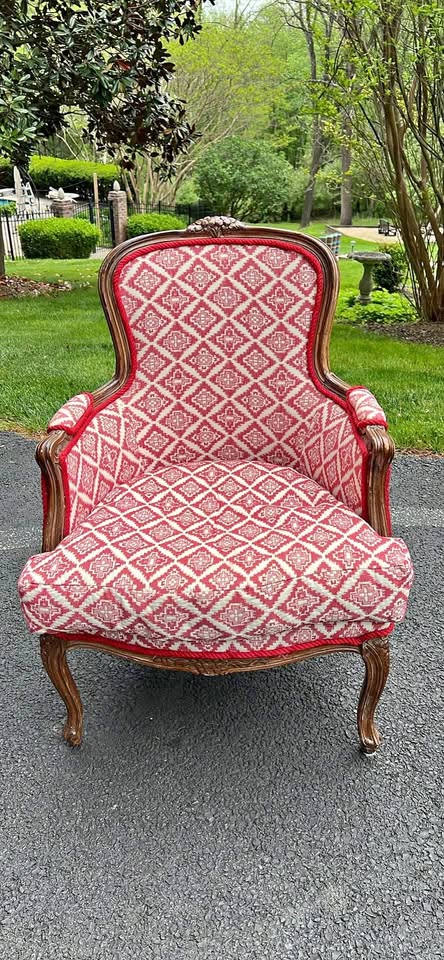
Brighten up your home with a patterned chair like this one that is way more exciting than any of the beige furniture on the market today. There’s no need to shy away from vibrant touches, after all—why not have a little fun?
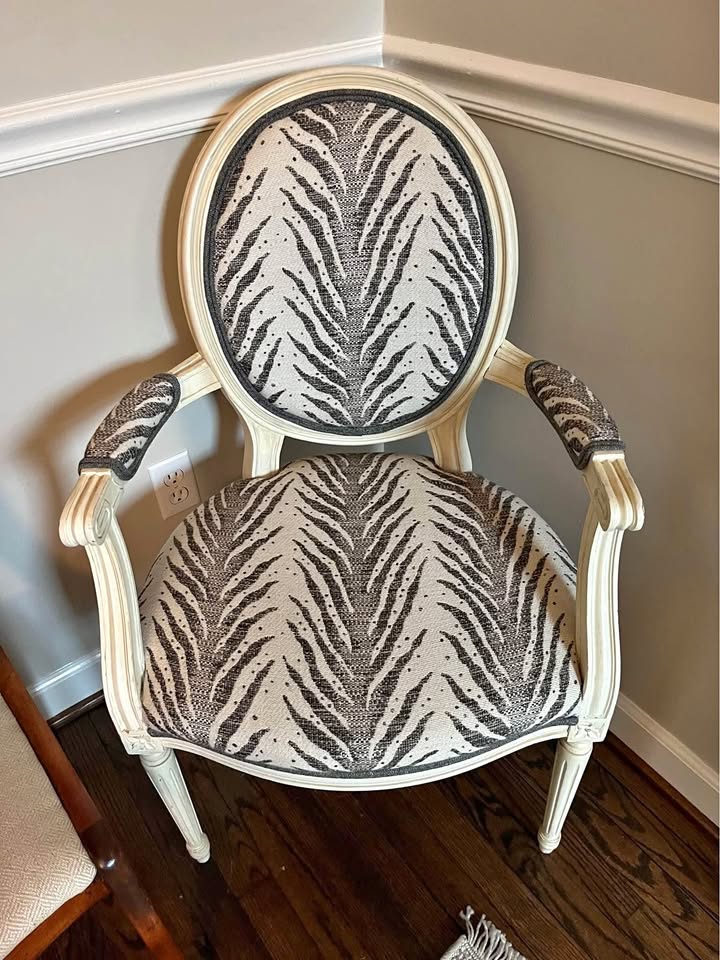
Here’s another chair that will add instant style to that empty corner in your living room or bedroom. Covered with luxe Schumacher fabric, it’s a design lover’s dream and an amazing opportunity to score a high-end piece for less. This chair would also be fabulous utilized as desk or vanity seating.
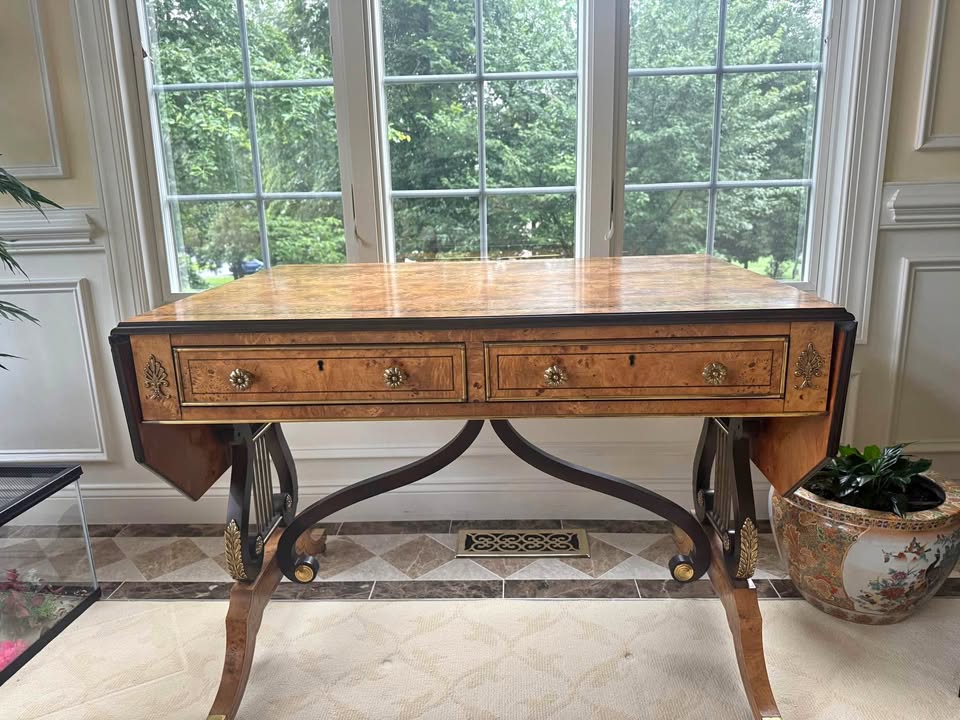
Speaking of desks, how stunning is this burlwood desk that doubles as an incredible statement piece? It would add so much dimension to any home office or bedroom (you could turn it into a dressing table, if you’d prefer) and is a forever type of piece that will never go out of style. There’s no need to source antiques like these overseas when you can scoop them up locally via Facebook!
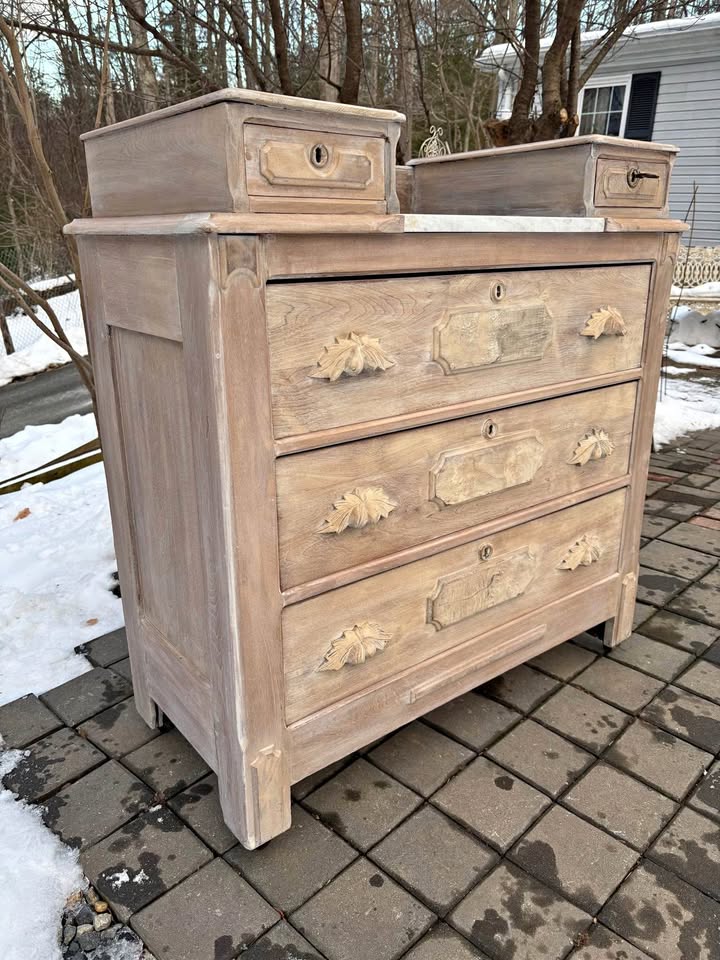
If you love European farmhouse style, don’t miss out on this refinished wooden dresser that could shine in a number of spots around the home: the entryway, nursery, guest bedroom, you name it. It’s spacious and classic and is way cooler than similarly priced pieces from IKEA.

Facebook Marketplace is also a great way to shop some of your favorite brands for less. These Anthropologie nightstands, for example, are listed for $250 each or $450 for the pair, marked down from the original $600/each price tag.
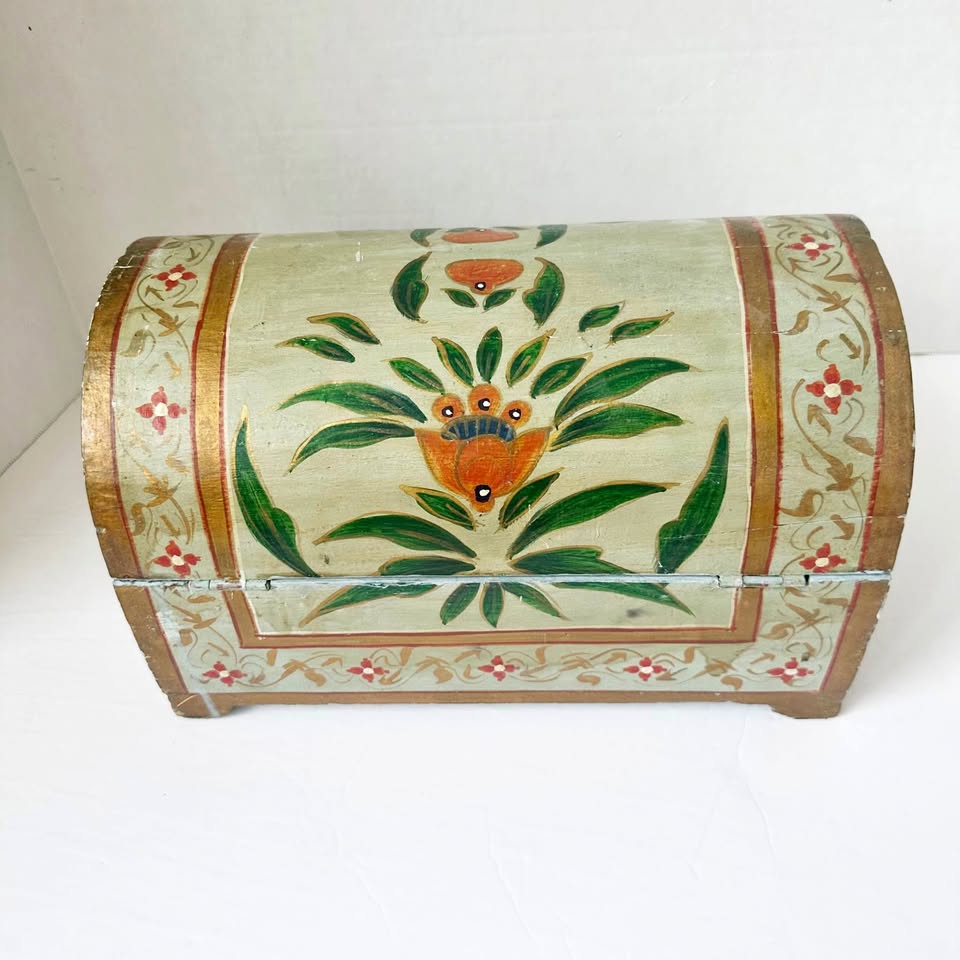
Facebook Marketplace is by no means just for furniture; you can score books, decorative accents, artwork, and more on the platform, too. This antique box will add so much character and charm to any shelf or dresser, whether you use it to store jewelry, hide remotes, or stash away love letters!

Sarah Lyon is a New York City-based freelance writer, originally from Bethesda, MD. She contributes to a number of national design and lifestyle publications like Architectural Digest, Apartment Therapy, MyDomaine, the Washington Post, and more. Sarah also works with designers to help them style spaces for photo shoots. Find more shelfies on her Instagram page, @sarahlyon9
Visit corcoranmce.com to search listings for sale in Washington, D.C., Maryland, Virginia, and West Virginia.
Don’t miss a post! Get the latest local guides and neighborhood news straight to your inbox!
Designing For Keeps: Timeless Trends in Custom Home Building
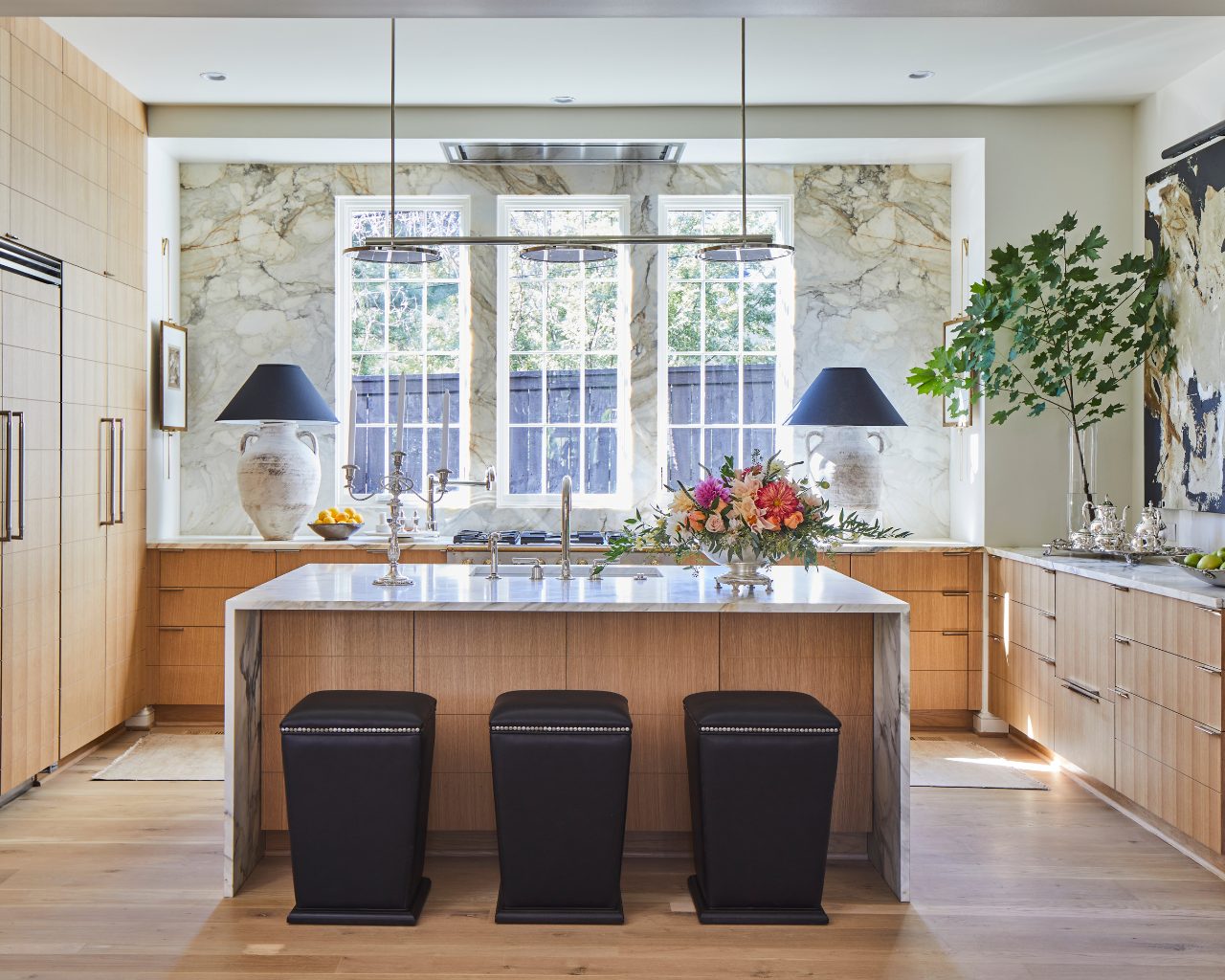
This week we would like to share inspiration from our partners at The Scout Guide.
We tapped husband-and-wife team Kevin and Leigh Misso, owners of River Brook Design & Build, a renowned full-service architectural design and construction company in Birmingham, Alabama, to get the scoop on what’s trending in home design. From building from the ground up to adding on or renovating, the lauded firm has a keen eye for detail and a pulse on upcoming trends, making them a go-to for creating timeless dream homes.
Honest materials
Opt for classic, genuine materials like wood, stone, and copper to elevate your home’s exterior. Think cedar roofing, copper gutters, and limestone accents for a sophisticated and timeless facade.
Eat-in kitchens
The heart of the home is returning to its roots. Embrace a more traditional table experience in the kitchen, whether it’s a breakfast nook or a full-fledged table, to foster connection and togetherness.
Prep kitchens
Also known as working kitchens, these adjacent spaces dedicated to food prep and cleanup will keep the main kitchen tidy and guest-ready — a must for entertaining.
Multiple islands
Enhance the functionality and flow of your kitchen by separating the island into two distinct work areas with a pathway between.
Open concepts reimagined
The open concept gets a refresh. Create defined spaces for different activities — think interconnected spaces that offer both togetherness and separation.
Cozy reading nooks
Carve out peaceful escapes for relaxation and reflection with inviting reading nooks furnished with built-in benches and clever storage solutions.

Color drenching and wallpaper
Embrace bold colors and statement wallpapers. Painting walls, trim, and ceilings in the same hue, otherwise known as color drenching, creates a dramatic and immersive effect that actually tricks the eye into believing ceilings are higher.
Luxurious bathroom retreats
Elevate your bathroom with his-and-hers vanities, separate primary closets, and specialty cabinet inserts for hair styling tools.
Seamless indoor-outdoor living
Blur the lines between indoors and out with screened-in porches, patios, and outdoor kitchens that become extensions of the home.
Photography by Laurey Glenn; design & construction by River Brook. River Brook appears in The Scout Guide Birmingham. Discover more of River Brook’s portfolio, here.
Visit corcoranmce.com to search listings for sale in Washington, D.C., Maryland, Virginia, and West Virginia.
Don’t miss a post! Get the latest local guides and neighborhood news straight to your inbox!
Beautiful Blooms: How to Plant a Cutting Garden

From our partners at The Scout Guide, they have provided tips on how to get your garden in shape for summer.
Summer is just around the corner and that means it’s time to get our gardens in shape. If cultivating a cutting garden is on your Spring to-do list, we’re here to guide you through this fulfilling and seasonal act of self-care. We’ve sought advice from two Scouted green thumbs on how to successfully plant a cutting garden. To find a gardening expert in your area, consult The Scouted Directory.
1. Make a plan
To create a flourishing garden, Kathy Sims, manager of Westland Gardens in Fort Worth, Texas, recommends selecting plants that are appropriate for your planting zone. “It is important to prepare and test your soil before planting,” she explains. “Staggering your plantings of seeds and planting them during the correct season is also crucial.” By following these tips and choosing flowers that you love, you can transform any space into a beautiful and fragrant garden that reflects the changing seasons.
2. Create color and texture
 Image courtesy of Westland Gardens. Photography by Jason Kindig.
Image courtesy of Westland Gardens. Photography by Jason Kindig.
To ensure your cutting garden provides color, texture, and blooms all season long, consider planting a mix of flowers such as zinnias, sunflowers, tulips, peonies, and dahlias. Sims also suggests supplementing your flowering plants with foliage plants, like dusty miller, eucalyptus, baby’s breath, ferns, and ivy, to add visual interest and volume to your floral arrangements. Herbs, such as basil, can also be included in your cutting garden.
3. Prevent pests
Preventing pests from taking over your blooms is an important endeavor and one that cannot be ignored. James Martin, founder of Gulfside Landscaping in Pensacola, Florida, urges gardeners to avoid using pesticides when possible, as they tend to kill the good insects that eat the bad insects. Instead he offers up a tried and true DIY solution. For small gardens (under 100 square feet), combine two teaspoons of Dawn dish soap, four ounces of beer, six drops of peppermint essential oil, and tap water in a hand sprayer. For larger gardens use a hose end sprayer — a canister that attaches to the end of an ordinary garden hose. With four tablespoons of Dawn Dish liquid, half a can of beer, and twelve drops of peppermint essential oil to treat the entire garden. “Work diligently to not overwater or under water your garden,” Martin adds. “The ground surrounding the roots of the plant should be moist without standing water.”
4. Cut with care
 Image courtesy of Gulfside Landscaping. Photography by Phillip Makselan
Image courtesy of Gulfside Landscaping. Photography by Phillip Makselan
Before harvesting your blooms, ensure your pruning shears are clean. Martin suggests using a diluted bleach and water solution to sanitize them, then hand dry, oil and wipe them down. This helps prevent cross-contamination from previous use. When cutting, find blooms that are just starting to open and cut the stem at a 45-degree angle to your desired length.
5. Maintain your blooms
To keep your cut flowers fresh, Martin advises adding a floral preservative to the vase water. You can make your own with sugar and vinegar, or use a commercial product that often contains a small amount of bleach to combat bacteria.
TSG Tip from Kathy Sims of Westland Gardens in Fort Worth, Texas, and James Martin of Gulfside Landscaping in Pensacola, Florida. Westland Gardens appears in The Scout Guide Fort Worth. Gulfside Landscaping appears in The Scout Guide Gulf Coast.
Keep your inspiration blooming with more Scouted tips from experts across the network.
Visit corcoranmce.com to search listings for sale in Washington, D.C., Maryland, Virginia, and West Virginia.
Don’t miss a post! Get the latest local guides and neighborhood news straight to your inbox!
Items You May Be Forgetting to Part with As You Spring Clean

Springtime and organization projects go hand in hand, but there are some areas of the home that you may be forgetting to tackle as you take on this year’s tasks. Below, pro organizers located throughout the DMV highlight six types of crucial items that they recommend sorting through this season to get your space into tip-top shape.
Winter Clothes
“As you switch out your closet from fall/winter to spring/summer, it’s a great time to evaluate and let go of any winter clothes that are stained, torn or ripped, don’t fit, or are no longer your style. If you didn’t wear it this winter season, it’s also a great candidate for letting go and donating! Why keep and store something that no longer serves you?” — Blake Jones, The Organizing Boss

Kids’ Winter Clothes
“Relatedly, children’s winter clothing is another great item to declutter. Unless you have a younger child who will eventually need that size, what fits your child now won’t fit them next winter. Take this opportunity to donate those items to a friend or family member, or a local nonprofit.” — Blake Jones
Reusable Tote Bags
“Over the year, we tend to collect a lot of reusable tote bags, and they end up piling up in a kitchen cabinet or closet. Take an opportunity to sort through the bags and get rid of the ones that are ripped or badly stained. And then be sure to wash the ones you want to keep; they get incredibly dirty and germ-ridden when used for groceries, shoes, and everything else we stuff into them.” — Blake Jones
Old Linens
“Many of us hold onto mismatched sheets, worn-out towels, and extra bedding ‘just in case,’ but these items take up valuable space and rarely get used. A quick project is to sort through your linens and keep only the best sets for each bed in your home. Donate or repurpose any extras—animal shelters often appreciate old towels and blankets!” — Angela Nguyen, Bring it Home Style
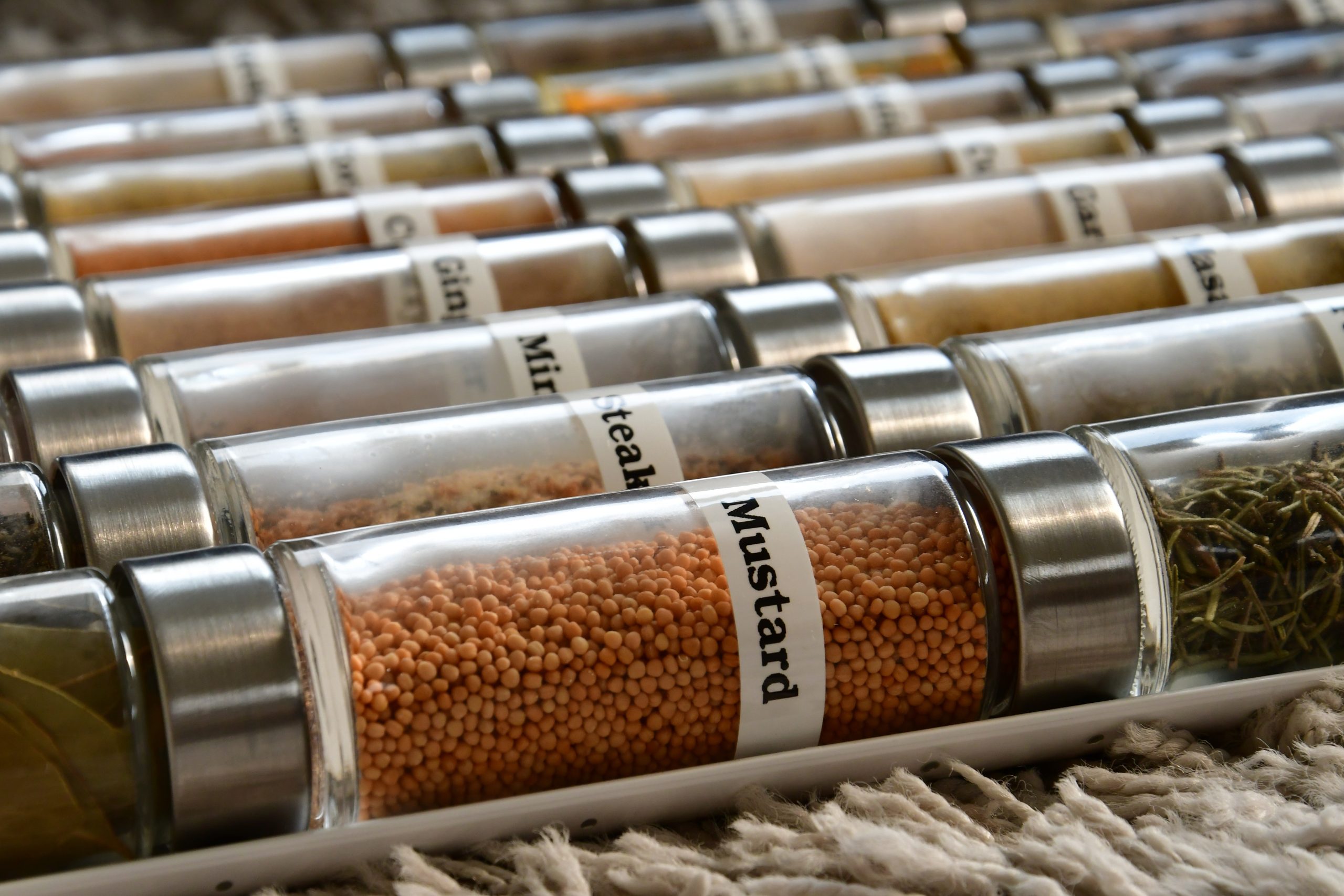
Spices
“Take a moment to check the expiration dates on your spices. While you likely use staples like cinnamon, garlic powder, and oregano regularly, when’s the last time you used marjoram, cardamom, or coriander? These spices often take up space without being used. Old spices can lose their flavor and potency, making your dishes less flavorful. Tossing out expired or rarely-used spices refreshes your kitchen and improves the taste of your cooking. Replacing them is inexpensive, and a more organized space will make your kitchen feel more functional and enjoyable to cook in.” — Kelly Tait, Bee Organized Northern Virginia
Shed Items
“Donate old bikes, and throw away that old cooler that you never use and those cracked pots. Clearing out helps you reclaim valuable space. Also knowing exactly where everything is makes vacations and weekends more stress-free.” — Amy Smucker, Amy Smucker Home Organization

Sarah Lyon is a New York City-based freelance writer, originally from Bethesda, MD. She contributes to a number of national design and lifestyle publications like Architectural Digest, Apartment Therapy, MyDomaine, the Washington Post, and more. Sarah also works with designers to help them style spaces for photo shoots. Find more shelfies on her Instagram page, @sarahlyon9
Don’t miss a post! Get the latest local guides and neighborhood news straight to your inbox!
A Scouted Weekend Getaway to Keswick Hall

From our partners at The Scout Guide, if you are looking for a weekend getaway to Charlottesville Virginia, then you should checkout Kenswick Hall.
A short drive from the bucolic college town of Charlottesville, Virginia, you’ll find historic Keswick Hall, a renowned resort where you can unwind, escape, and relax. We’ve planned a four-day itinerary to ensure you make the most of your long weekend at the resort and the surrounding area. Read on and then use THIS link for a special exclusive offer for The Scout Guide readers booking this spring. An unparalleled retreat is waiting for you!
THURSDAY

Keswick Hall. Photography courtesy of Keswick Hall.
Arrive and valet your car curbside with a warm, personalized greeting by the Keswick Hall Guest Services team. Unload all worries and step onto your balcony overlooking the award-winning Full Cry golf course, while gazing upon panoramic views of the majestic Blue Ridge Mountains.

Craft cocktail and small bites at Crawford’s. Photography by Kate Thompson.
Slip downstairs to sip on a custom-crafted cocktail, such as the famous Old Fashioned at Crawford’s.
Retreat to your room and indulge in a relaxing evening at your own leisure. Sipping champagne on your balcony in your provided bath robes and slippers would be a wonderful way to ease into your stay.
FRIDAY

Marigold by Jean-Georges. Photography by Brandon Barre.
Awaken refreshed after a restful slumber on your luxurious Duxiana mattress, while basking in the glorious views of the Keswick countryside at sunrise. Head downstairs to The Counter for a complimentary specialty coffee prepared by Keswick Hall’s skilled baristas, then enjoy a delicious breakfast at Marigold.

A view of the Full Cry golf course. Photography courtesy of Keswick Hall.
Gear up in high fashion with both attire and equipment featured exclusively at The Keswick Club Golf Shop. Down at the range, the attentive staff of golf professionals will be on hand to assist in providing an exceptional round on the meticulously maintained Full Cry golf course; which is ideally suited for both seasoned and novice golfers alike. Venture into Charlottesville and linger over linguine alla carbonara while sipping a delicious Chianti at the local’s favorite, Tavola, in the historic Belmont district.
SATURDAY

The Spa at Keswick Hall. Photography by Brandon Barre.
Begin a day of ultimate relaxation with a power smoothie from Marigold as you head to The Spa at Keswick Hall. Indulge in a couple’s massage, and emerge radiant following an Intuitive Facial, featuring products by the renowned luxury Swiss skincare brand, Valmont.
Pop over to the whimsical and highly Instagrammable Merrie Mill Vineyards for a delicious charcuterie lunch and enjoy a lovely glass of Viognier in the heart of Wine Enthusiast’s Wine Region of the Year for 2023.
SUNDAY
If you’re in deep relaxation mode and can’t bear to leave the property, lounge in serenity by the stunning Horizon Pool.

Cuisine at Keswick Hall. Photography by Brandon Barre.
Cap off your stay by savoring the carefully curated menu at Marigold with cuisine inspired by legendary chef Jean-Georges Vongerichten.
Returning home, you’ll carry the quiet luxury of Keswick Hall with you long after the weekend fades.
Ready to book your Scouted weekend getaway to Keswick Hall? Use THIS link for a special exclusive offer for The Scout Guide readers this spring. To make the most of your trip, visit The Scout Guide Charlottesville for the best ways to connect with local businesses in the area, exclusive Insider Guides, event listings, and more.
Visit corcoranmce.com to search listings for sale in Washington, D.C., Maryland, Virginia, and West Virginia.
Don’t miss a post! Get the latest local guides and neighborhood news straight to your inbox!
Before Amazon, There Was Sears, Roebuck & Co.
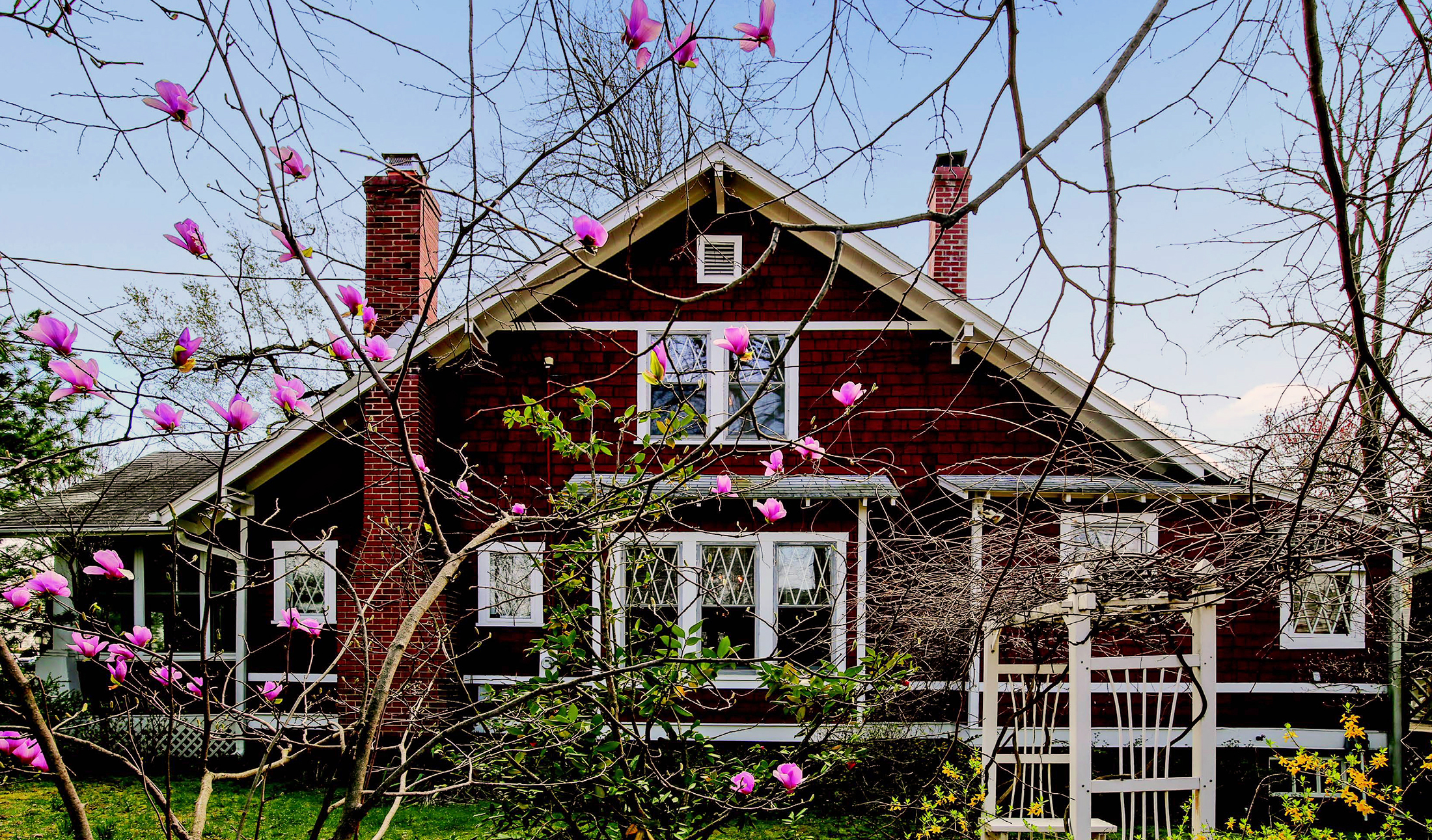
Many local residents are delighted to own a piece of American architectural ingenuity from the storied Sears, Roebuck and Co.
“The 1920s were roaring, the stock market was soaring, and R.B. Craddock ordered his Alexandria dream home from the Sears, Roebuck and Company catalog. His rare 1922 Arts-and-Crafts house at 2804 King Street has been lovingly preserved by [the only two owners] to live in this architectural gem.”
So began the 2019 listing notes by Corcoran McEnearney Suzanne and James Morrison for a charming, historical property that is often referred to as a “Sears Kit Home,” and is coveted by many architecture enthusiasts today, not just for its historical importance in the creative way it brought modern homebuilding to the masses but for an enduring legacy in the current resale market.

Side view of 2804 King Street, Alexandria. Note the diamond windowpanes – a classic Sears Modern Home detail. Photo courtesy James & Suzanne Morrison.

Interior of 2804 King Street, Alexandria showcases the diamond window pattern that is repeated in the built-in bookshelves dividing the living and dining rooms. And yes, the fireplace – including glass tiles – came in the kit! Photo courtesy Suzanne & James Morrison.
Sears, Roebuck & Co. sold its Sears Modern Home Program kits from 1908 to 1942 via its massively popular catalog, which at the time was delivered to one-fifth of American households. Over the years, buyers could select from more than 370 designs in a multitude of sizes and styles, with the most popular designs repeating each year and others being showcased just once. A 25-ton kit contained around 10,000 pieces of framing lumber, 20,000 cedar shakes, and nearly everything else a home might need could also be purchased to accompany the kit, including plumbing, lighting, fireplaces…even down to the doorknobs! They were shipped throughout the country by railcar, with most being delivered along the East Coast and Midatlantic and Midwest states where railway stops were plentiful. The Washington, DC area became a popular region for construction with more than 2,000 homes being built in the 40+ years the kits were available, many of which still exist today for buyers eager to own their own piece of Americana.

Cover of 1922 Sears Modern Home Catalog, courtesy of Wikipedia.
While Del Ray Alexandria is renowned for its collection of Sears homes, there are many other local neighborhoods where a few hundred of these eclectic homes can still be found. Agents Richard McGuire and Lisa Smith’s recent listing (currently under contract) in Arlington is just one of those finds. Built in 1931, this home features many of the original details found in classic Sears’ models, including rounded doors and archways and hardwood floors. McGuire noted that there are architectural surprises throughout the home, including a little cut-out in the dining room that served as the location for the home’s one and only telephone.

This listing at 912 S Quincy Street, Arlington is a 1930s Barringer model. Photo courtesy of Richard McGuire and Lisa L. Smith.
Like many Sears’ owners, residents over the years have made renovations to the home while still keeping the original character of the home. “They were designed so each room served a specific purpose, whereas today homes have a more open-concept approach,” Richard said. “It may be a little boxy by today’s standards but the home is just so well made.”
The Morrisons’ Alexandria listing was a combination of two kits built together: a main level and a second story, which made for an interesting back-of-the-house location for the stairwell, James noted. The property also came with a garage, and while they couldn’t verify that it was also a kit-build, the fact that the doors opened to the side like a carriage house rather than from top-to-bottom could be a sign it was from Sears.
As with many vintage and historic properties, there is room for debate about “provenance” and whether something qualifies as an “authentic” Sears Modern Home. There were many competitors in the kit home business, including Aladdin (1906-1981), the first company to offer mail-order homes; Gordon-Van Tine (1907-1947), which diversified and offered buyers mortgages; and Lustron (1948-50), which constructed homes out of porcelain laminated steel. As these companies went out of business, so did their archive of sales documentation. This leaves many owners searching through their own paperwork to determine which type of kit home might be theirs.
Agent Darlene Duffett recently discovered that her family’s home in the Rosemont neighborhood of Alexandria might not actually be a Sears kit home, even though when they bought their home on W. Alexandria Avenue, neighbors shared stories about it being a Sears home and surmised that there was a plaque in the basement that had since been covered up. The Duffetts have yet to find evidence of that and no documentation came with the sale that could solve the mystery. However, they can confirm that their garage was built by a Sears kit thanks to a plaque that was installed above a side door.

The plaque that certifies this little garage in Rosemont is from Sears Modern Home. Photos courtesy of Darlene Duffett.
Buyers who value the charm and vintage details of older homes are fortunate that this region has enough kit homes remaining to offer hope that one might come up for sale. If your goal is to own a Sears Modern Home or any other historic kit properties, connect with one of our Corcoran McEnearney agents to help deliver your own piece of history.
Visit corcoranmce.com to search listings for sale in Washington, D.C., Maryland, Virginia, and West Virginia.
Don’t miss a post! Get the latest local guides and neighborhood news straight to your inbox!
The Moses Hepburn Rowhouses: A Legacy of Resilience, Wealth, and Community Leadership

Photo credit: Calder Loth, 2023
Moses Hepburn fought tirelessly for the education, rights, and dignity of African Americans. The Alexandria Old Town rowhouses that bear his name are a powerful symbol of an enduring community spirit.
Nestled in the historic district of Alexandria, Virginia, the Moses Hepburn Rowhouses stand as a testament to the perseverance, resilience, and business acumen of one of the wealthiest and most influential African Americans in the 19th century. These four historic rowhouses, located at 206 N. Pitt Street, are not just buildings—they represent a rich story of legacy, struggle, and triumph against the backdrop of a turbulent era in American history.
Listed on the National Register of Historic Places in 2004, the Moses Hepburn Rowhouses continue to shine a light on the remarkable contributions of African Americans to the development of Alexandria and the broader Northern Virginia region.

2021: Moses Hepburn Rowhouses from the north. Courtesy of John Chapman.
The Historical Significance of the Moses Hepburn Rowhouses
Constructed around 1850, the Moses Hepburn Rowhouses were originally built as a set of four identical two-story, two-bay side hall plan dwellings. These elegant rowhouses are among the few remaining architectural relics from the period, offering a glimpse into the lifestyle of a successful African American businessman during a time when such success was a rarity. Though these homes were once identical, the unit at 206 N. Pitt Street underwent updates in the late-19th century, reflecting the evolving tastes and needs of their inhabitants. Each rowhouse has also seen one- or two-story additions in the rear, signifying the ongoing adaptations of the homes as they served as both residences and symbols of wealth and influence.
While the architecture of these rowhouses is compelling, their significance extends far beyond their design. Moses Hepburn, the man behind these homes, is a key figure whose personal story is intricately woven into the fabric of Alexandria’s history.
Moses Hepburn: From Enslavement to Empowerment
Moses Hepburn’s story is nothing short of extraordinary. Born in 1806, he inherited great wealth from his father, a prosperous white merchant and a member of the Alexandria City Council. However, Moses’ early life was marked by the cruel realities of slavery. His mother, Esther, was enslaved to his father until 1816 when she and her children were sold to her free black sister, Harriet Jackson. Eleven days after the sale, Harriet Jackson freed Esther and her children, and Moses’ journey toward freedom began.
The legacy of his father, combined with the powerful act of his mother’s emancipation, shaped Moses Hepburn’s future. His father’s will provided for his children, particularly Moses, ensuring that he would be educated and financially supported. Moses attended school in West Chester, Pennsylvania, a progressive city where he could receive an education that would not have been available to him in Virginia. Upon completing his education, Moses returned to Alexandria, where he established himself as a successful businessman, civic leader, and philanthropist.

Roberts Memorial United Methodist Church. Courtesy of John Chapman.
Moses Hepburn’s success was not just limited to his wealth but also his ability to navigate the complex social and political systems of his time. He used his prosperity and influence to advocate for his community, playing a vital role in the founding of Davis Chapel, later known as Roberts Memorial, one of the oldest African American churches in Alexandria. His leadership extended beyond religious endeavors as he worked tirelessly to improve the lives of African Americans in Northern Virginia.
The Impact of Moses Hepburn’s Wealth and Influence
By all accounts, Moses Hepburn became the wealthiest free African American in Northern Virginia. His wealth, accumulated through shrewd investments and business ventures, allowed him to live a life of comfort and security—something that was rare for African Americans during the antebellum period. He was known for his astute real estate dealings and for using his financial success to benefit not only his family but also the African American community in Alexandria.
One of Hepburn’s main goals was to provide an education for his eight children. In pursuit of this goal, he sent his son Moses Hepburn Jr. to school in Washington, D.C. However, this decision would prove to be a controversial one. In 1847 Alexandria was retroceded to Virginia and Virginia passed laws forbidding the education of African Americans. When Alexandria authorities learned of Hepburn’s actions, they gave him an ultimatum: leave the state or face severe consequences. This threat to his family’s future, combined with the increasingly hostile racial climate in Alexandria, prompted the Hepburn family to relocate to West Chester, Pennsylvania, where Moses Hepburn continued to live and prosper.
Legacy of the Moses Hepburn Rowhouses
The Moses Hepburn Rowhouses not only represent the wealth and success that Moses Hepburn achieved but also the enduring legacy of a man who fought tirelessly for the education, rights, and dignity of African Americans. In 2004, the rowhouses were added to the National Register of Historic Places, ensuring that the story of Moses Hepburn and his contribution to the fabric of Alexandria’s history will not be forgotten.
These homes, standing proudly on Pitt Street, are a lasting reminder of the struggle and perseverance of an African American family that rose from the ashes of slavery to become leaders in their community. Today, the Moses Hepburn Rowhouses continue to serve as a historical landmark, reminding residents and visitors alike of the rich African American history that helped shape Alexandria.
For those interested in exploring Alexandria’s storied past, particularly the contributions of African Americans to the city’s development, the Moses Hepburn Rowhouses are an essential part of the narrative. They stand as a powerful symbol of resilience, perseverance, and the enduring spirit of a community determined to carve out its own space in history. As Alexandria’s real estate market continues to evolve, the Moses Hepburn Rowhouses will remain a treasured historical site that reflects the city’s deep connection to its past.
For prospective homeowners or history enthusiasts, the legacy of the Moses Hepburn Rowhouses is a reminder of the importance of preserving historical landmarks that not only add character to a neighborhood but also tell the compelling stories of those who paved the way for future generations.

JOHN CHAMPMAN
John Chapman is a fourth-generation Alexandrian, the founder of Alexandria’s Manumission Tour Company, and a fourth-term member of Alexandria’s City Council.
30 Minute Organizing Tasks to Take on This Month
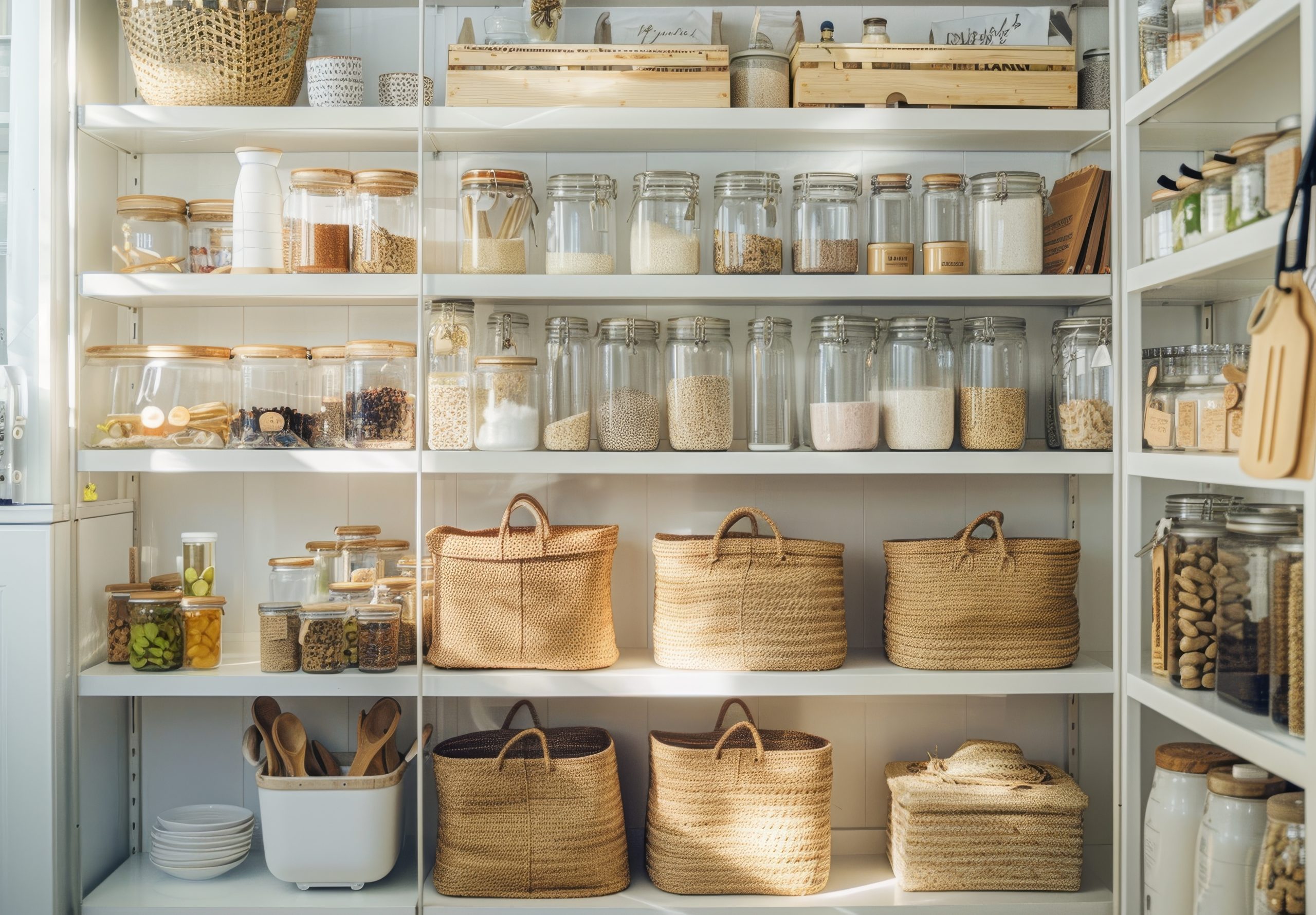
January means it’s time to get organized! Daunted by the idea of addressing your entire home in an entire day? There’s no need to do so—instead, break down your tasks into chunks so that everything feels much more manageable. In fact, you’d be surprised at how much you can tackle in just 30 minutes! Pick one of these half-hour tasks from DMV area pro organizers to do every day this week and watch the state of your home transform right before your eyes.
Refresh Your Bathroom Countertop
You utilize your bathroom countertop every day, multiple times a day, but when was the last time you really gave it an overhaul? Eryn Donaldson, the founder of The Model Home, recommends taking 30 minutes to edit your setup to get rid of unused products, expired items, and clutter. First, remove everything from your countertop and then toss the things you never reach for or are in poor condition. “Wipe down the surface and return only the essentials, perhaps grouping them in a small tray or organizer,” Donaldson instructs. “This small change can make your mornings feel more serene and streamlined.”
Sort Through Paperwork
Make this the year that you stop letting paperwork accumulate in your home. “Grab one stack of papers—whether it’s mail, bills, or miscellaneous documents—and dedicate 30 minutes to sorting, shredding, or filing,” Donaldson suggests. “Reducing paper clutter not only frees up space but also ensures you don’t miss important documents, giving you peace of mind as you start the new year.” Be sure to then pick up some file folders where you can safely keep the documents you do need.

Photo courtesy of Professional Organizer Lisa Malone
Address a Small Section of the Closet
You’ll likely need more than 30 minutes to organize your entire closet, but you can definitely address a small section of it in this amount of time—maybe your blazers or button-downs. “As you go through your items, sort them into four categories: keep, donate, relocate, and discard,” says Lisa Malone. She notes that most people only wear about 20 percent of their clothes. “Often, those favorite pieces are in the laundry or sitting on a chair because our closet is cluttered with things we don’t wear or that don’t belong there,” she says.
Deal with the Junk Drawer
Let’s face it, everyone has a junk drawer! If yours is looking a little chaotic, follow Rachel Rosenthal’s advice and spend 30 minutes dealing with it. “Start by emptying the drawer, tossing trash, and grouping similar items together, like pens, batteries, or takeout menus,” says the founder of Rachel & Company. Once you have done this, take measurements of the drawer. If you have small containers or dividers on hand, add them inside, otherwise, you can order a few. In the meantime, it’s fine to store items by category in Ziploc bags, notes Cheryl Larson, the founder of Cheryl’s Organizing Concepts.
“This project is valuable because it transforms a chaotic space into one that works for you, making it easier to find what you need and reducing daily frustration,” Rosenthal says.
Keep in mind that not everything that was originally in your junk drawer needs to stay in there. “Decide what items are better somewhere else,” Larson says. “Batteries, markers, and notepads are nice to have at hand, personal items might be better in your bathroom or purse, and office supplies can go in your desk.”
Go Through the Pantry
When was the last time you sorted through all of your canned and dried goods? “It’s important we start the year off right, starting with getting rid of expired food,” says Lavender Menakaya, the founder of Lavender Organizes. She offers a tip for making this process less overwhelming. “Instead of pulling everything out, concentrate on one or two categories of food like canned goods or spices,” the organizer says. “Simply throw out or donate the expired food and put back the non-expired food,” she adds, noting that the following week, you can move on to the next category of food.
Sort Through Your Car
One final 30-minute organizing project you can tackle this month is organizing the storage compartments in your car. Caroline Dockery, the founder of Categorically Caroline, recommends going through the glove box, arm console, back seat pockets, and more. “Discard trash, consolidate important items into an easy-to-reach bag or bin, replace cleaning or personal hygiene items, and double check car maintenance things like emergency kits, tire pressure gauges and the like,” she says. “It’s also a great time to verify when your car registration will be due this year!”

Sarah Lyon is a New York City-based freelance writer, originally from Bethesda, MD. She contributes to a number of national design and lifestyle publications like Architectural Digest, Apartment Therapy, MyDomaine, the Washington Post, and more. Sarah also works with designers to help them style spaces for photo shoots. Find more shelfies on her Instagram page, @sarahlyon9
Don’t miss a post! Get the latest local guides and neighborhood news straight to your inbox!
Keeping Your Pets Safe During The Holidays

Our furry soulmates are an important part of our holiday tradition and they’re counting on us to keep them safe.
It’s the most wonderful time of the year!
Unless you’re a beloved pet. In that case, it might be confusing, scary, and chaotic. That’s because while their humans may be bustling to & fro’ and bringing festive cheer into their homes, there are new things for pets to discover and navigate that can create a disruptive scene for our creatures of habit.
To help keep your pets safe this holiday season we’ve compiled a list of Do’s and Dont’s to keep the scaries away… and avoid an unwanted trip to the vet’s office.
DO
- Consider an artificial tree. In addition to eliminating a dog’s tendency to, um, “claim it as their own,” it takes away a pet’s temptation to eat the needles and drink reservoir stand water which can have harmful additives.
- Whichever tree you choose, make sure it’s secured or out of reach of curious animals. (This is true for toddlers, too!) There are endless hilarious clips of what happens when pets (and to be honest, it’s mostly cats) are tempted to climb to new heights.
- Keep your trees, lights, or other large ornamental pieces securely anchored so they don’t tip and fall or break. Not only will this protect your prized ornaments but it will prevent all that weight from falling onto your pet.
- When hosting holiday parties, be conscious of your pet’s needs and your guests’ needs (especially those who are uncomfortable around animals). Make sure your pet has a quiet space to retreat to when they feel shy or overwhelmed. Check on them occasionally and be sure there is plenty of fresh water and a place to snuggle safely until things have quieted down.
- Have calming snacks, weighted blankets, or anti-anxiety medication for animals that need a little extra care during festivities.
- Keep food and drinks out of reach and secure the lids on garbage and recycling cans. Also, guests (especially the kiddos) should be discouraged from feeding pets from holiday plates.
- Be sure to remove pet hair that can trigger allergies, keep cages and litter boxes fresh, and have towels and cleanser handy for any slobbery kisses that get shared.
- Check with your vet at what temperature your pet might need a sweater, and remember to take it off inside to avoid overheating. For dogs, especially, take extra good care of their paws; try winter booties, wipe their paws after walks, and try to avoid stepping in salt or ice melt on walks. Be sure to rinse their paws as soon as possible to prevent harmful chemicals from being ingested or absorbed through the skin or paw pads. (FYI – sand is much more animal-friendly than chemical melts!)
- If you live in an area prone to power outages during storms or freezing temperatures, keep medications, food, clean water, and toys handy in case you need to evacuate or bunker down.
DON’T
- Avoid holly, mistletoe, and poinsettias which can cause gastrointestinal issues and cardiovascular problems.
- Even small amounts of alcohol or other intoxicants are definite no-no’s so keep drinks and edibles out of reach. If ingested, your pet might get weak, ill, or go into a coma, possibly resulting in death from respiratory failure.
- Keep human foods away from pets as well, especially chocolate or anything sweetened with xylitol. Also harmful: fatty or spicy food, garlic, onions, and bones are not to be given to animals. A Partridge in a Pear Tree sounds like a cute photo op for your fine-feathered friend, but birds may ingest small ornaments or other bits of harmful greenery.
- Animals are very sensitive to strong fragrances so avoid spraying fragrances or putting scented candles nearby.
- Speaking of candles, it’s probably best to keep them out of your holiday décor. Yes, they are beautiful and cast a lovely seasonal glow, but they can be easily knocked over – or light up a tail! – in the midst of holiday excitement. Stick with battery candles instead.
- And… speaking of fires, don’t let your pets get close to open heat sources which can pose serious burn risks. Keep a firescreen up around any fireplaces (gas or woodburning), keep radiators covered, and keep kerosene or electric space heaters out of reach of curious paws and claws.
- Don’t forget Santa’s reindeer! While it might be tempting to leave these magical creatures holiday goodies like cookies and candy, it might hurt their tummies. Best to leave them a plate of what the American Veterinary Medical Association suggests: hay and reindeer feed, with the occasional graham cracker Christmas cookie as a treat. They also eat mosses, grass (when it’s not covered with snow) and lichens.
The holidays are a special time to make memories both for yourself and your beloved pet. Following these simple tips will ensure your animals stay safe into the New Year and beyond!
Take a look at our website for all of our listings available throughout Washington, D.C., Maryland, and Virginia.
Don’t miss a post! Get the latest local guides and neighborhood news straight to your inbox!
![]()
Follow Along with These 8 DMV Creatives

While not explicitly known for its creative scene, the DMV area is home to many talented designers, artists, shop owners, and more, all of whom enjoy chronicling their local adventures on Instagram. If you’re looking for some new creatives to follow, you’ll definitely want to get to know the eight individuals profiled below. Here, we asked them about their favorite DMV spots, top places to bring visitors, go-to meals, and more.

Spencer Beck
Based in Ashburn’s One Loudoun neighborhood, artist Spencer Beck has called the DMV home for the past 10 years. Follow him to keep tabs on his artwork, DMV adventures, vintage home finds, and more. Beck adds, “I also love sharing the gorgeous and wildly overpriced things that my husband refuses to buy for me!”
What do you do for a living?
I am an artist, making line drawings, acrylic paintings, collages, and an apparel line with my designs. My originals are in private collections all over the world, and my work can be found in local shops in Downtown Leesburg like Muz & Rose and wldwst.
What are some of your go-to DMV spots?
I love going to Café Riggs in Penn Quarter for their French 75, and my husband and I go to Eddie Merlot’s in One Loudoun for happy hour almost every week! I am also often found sipping a matcha latte with lavender and oat milk at Goosecup in Leesburg.”
What’s an underrated DMV spot that you think deserves a little more attention, and why?
My husband and I love to spend our weekends browsing local antique stores, and our most frequented stops are Pear Tree Cottage in Vienna and Elliott’s in Frederick. Both shops are fabulously curated by their exceptional owners, and we never leave without a new treasure for our home.
What’s your go-to spot to bring visitors?
The National Gallery of Art is always a go-to for out-of-town guests. Having access to world-class art in the Smithsonian—and admission being free—is such a fun thing to share with visitors. Being able to stop and meander for hours or just dash through to visit Van Gogh’s Self-Portrait is always a treat.
What’s your favorite meal in the DMV?
I’m a big brunch guy, and the cornflake-crusted French toast with fried chicken from Matt & Tony’s in Alexandria is my favorite brunch around! A close second: the thick-cut bacon from Saint Anselm in Union Market!

Mariella Cruzado
Interior designer Mariella Cruzado, based in the Shaw neighborhood of DC, is the founder of Splendor Styling and has called DC home since 2008. “My brand celebrates luxury living and aims to promote enjoying life to the fullest,” she says. Follow her to get inspired to celebrate the everyday.
What do you do for a living?
I run my own interior design studio serving DC, MD, and VA.
What are some of your go-to DMV spots?
Rock Creek Park, the Georgetown waterfront, the National Mall, and the Kennedy Center.
What’s an underrated DMV spot that you think deserves a little more attention, and why? Definitely West Potomac Park. It’s a nice escape inside the city in front of the water. There are gorgeous willow trees that provide you with shade, and depending on the time of the day it can be a quiet spot to enjoy reading a book or a light picnic at sunset.
What’s your go-to spot to bring visitors?
I’ll take them to the bar at the W Hotel/Hotel Washington overlooking the White House, have a nice picnic at West Potomac Park, go to any rooftop at the Wharf, or eat at Kafe Leopold in Georgetown, Causa/Amazonia in Blagden Alley, Wild Days rooftop at the Eaton Hotel, or the Lady Bird rooftop.
What’s your favorite meal in the DMV?
Rumi’s Kitchen in Shaw.

Matthew Dandy
A Northern Virginia native, photographer Matthew Dandy later lived in Baltimore for a decade before settling in Alexandria. “I currently live in Del Ray,” he says. “Special thanks to Hannah Lynn from The Lynn Group and McEnearney!” Follow him to keep tabs on beautiful interiors and architecture in the DMV (and to catch occasional cameos from his dog, Poe!).
What do you do for a living?
I am a photographer, specializing in architecture and interior design photography along with hotels and travel.
What are some of your go-to DMV spots?
King Street in Old Town, especially Founders Park for a picnic, Torpedo Factory for art, and Red Barn Mercantile or Shop Made in VA for unique gifts.
What’s an underrated DMV spot that you think deserves a little more attention, and why?
Planet Word Museum. It’s not as well known as the museums on the Mall, but is a totally unique experience and well worth the entrance fee.
What’s your go-to spot to bring visitors?
The Alexandria Waterfront or Mt Vernon Ave in Del Ray. Or we’ll take a quick Metro ride into DC for a museum trip.
What’s your favorite meal in the DMV?
Way too many to pick from, and the variety is amazing. Recently I’ve been really into Padaek and Spice Kraft.

Imani Keal
Dupont resident and content creator Imani Keal, who first moved to DC 10 years ago to attend Howard University, is committed to celebrating life at home. Follow her for DIY inspo and more. “I live by the motto, “Rent or own, love your home,’ so if you’re looking for design advice that’s budget and renter-friendly, I’m your gal,” she says.
What do you do for a living?
I’m a full-time content creator and interior decorator. Through my blog, Instagram, and TikTok, I create content showing people how to make the most out of their rentals.
What are some of your go-to DMV spots?
- Food: Reveler’s Hour, Martha Dear, Martin’s Tavern, Your Only Friend, Jane Jane, Albi, St. Vincent, Thomas Sweets, and Bagels, Etc.
- Shopping: Miss Pixie’s, Salt & Sundry, Made In DC, and The Phoenix.
What’s an underrated DMV spot that you think deserves a little more attention, and why?
In a city like DC where everything is expensive, I really love Jimmy T’s for breakfast because it’s cheap, delicious, and quick. No reservations, just walk in and enjoy. Perfect for a Sunday morning.
What’s your go-to spot to bring visitors?
It depends on the visitor! If it’s parents or someone I want to impress, I’d take them somewhere nice, but approachable, like Reveler’s Hour for family-style pasta and grilled chicken. If it’s a friend who loves cocktails and late-night fried chicken, I’m going to the Service Bar. And Old Ebbitt Grill is always on my list because I love shrimp cocktails and its easy-going service.
What’s your favorite meal in the DMV?
My current favorite meal in DC is at Your Only Friend. I get the Hot Nug, which is a sandwich with a fast-food-style chicken nugget, Nashville hot sauce, and chicken-style Duke’s Mayo. I also get the Irish Cream Soda cocktail. I never knew cream soda and Irish whiskey could be such a delicious combo.

Heather Bien
Heather Bien first moved to DC in 2008 and is currently living in the Capitol Hill neighborhood, where she and her husband are in the process of restoring a historic townhouse that had served as a group house for 20 years. Follow her to check in on the renovation process and learn more about weekend getaways in the DC area (and maintains a rental home on the Rappahannock River), vintage finds, and classic style.
What do you do for a living?
I’m a freelance writer, marketer, and content creator. I write for lifestyle publications, work with agencies and small businesses on email, website copy, and marketing materials, and I also create content on my blog and Instagram.
What are some of your go-to DMV spots?
I love to grab a coffee at Wine & Butter before strolling around Lincoln Park. Beuchert’s is a favorite date night spot of mine. I love popping over to Union Market for SHELTER and Salt & Sundry for gorgeous things for both me and my home. Of course, if I have a free afternoon, you can guarantee I’m escaping the city to go poke around the antique shops in Middleburg or Frederick. And, for a super casual, divey night, I always go back for the mozzarella sticks at Tune Inn, a bar that’s been on the Hill since the 1930s.
What’s an underrated DMV spot that you think deserves a little more attention, and why? This is a tough one because I feel like almost everywhere has been discovered! So rather than a restaurant or spot, I’d say it’s the creative scene that deserves more attention! There are so many people doing incredible things, whether they’re creative business owners, marketers, artists, or content creators, and it’s time people realize this isn’t just a one-industry town!
What’s your go-to spot to bring visitors?
I always bring visitors to the weekend market at Eastern Market. It’s a lively farmers market meets flea market vibe that shows the most vibrant, diverse side of DC. Picking up an almond croissant from the French baker who sets up outside is a must!
What’s your favorite meal in the DMV?
Oh gosh, this is impossible to narrow down! A classic is the Welsh Rarebit from Martin’s Tavern, one of the most iconic Georgetown institutions. You also can’t beat the food journey that is Compass Rose. A recent favorite is Kyojin, which I covered when it opened last year, and I just snagged a reservation to go back later this month.

Molly Acorn
Molly Acorn, the owner of Mantel House DC, was raised in the Maryland suburbs and left the area before later returning to raise her children on Capitol Hill. Follow her on Instagram for interior design and architecture inspiration, as well as plenty of antique and custom marble mantels!
What do you do for a living?
I’m the owner of Mantel House DC, which sells, sources, restores, and customizes antique marble fireplace mantels.
What are some of your go-to DMV spots?
My favorite local spots for food and shopping include Le Diplomate, District Doughnut, Toki Underground, Sushi Taro, Ella Rue, and Secondi.
What’s an underrated DMV spot that you think deserves a little more attention, and why?
The Barbie Pond on Avenue Q for a local, free exhibit that is sure to make you smile.
What’s your go-to spot to bring visitors?
Union Station, the National Mall, the Library of Congress, the Botanical Gardens, Eastern Market, and Yards Park.
What’s your favorite meal in the DMV?
Le Diplomate: It has a great brunch, the best burger, and outstanding service.

Libby Rasmussen
Having lived in DC for 13 years, Libby Rasmussen now calls the Mt. Pleasant neighborhood home. Follow her on Instagram, where she enjoys sharing new restaurants, small businesses and artists, and a bit of design inspiration. “My page is a reflection of my passions and interests, where I delight in sharing glimpses of my life and the things that bring me joy,” she says.
What do you do for a living?
I have a social media and marketing company, Living Colorfully Media, and a DC-based home décor and vintage store, LIBBY & MY.
What are some of your go-to DMV spots?
- To Eat: Thip Khao, Compliments Only.
- To Shop: Ron David Studio, LIBBY & MY, Georgetown Opportunity Shop, Goodwood.
- For Art: Chela Mitchell Gallery, Hirshhorn, Stable Arts.
- For Outdoors: National Arboretum and Kenilworth Park & Aquatic Gardens
What’s an underrated DMV spot that you think deserves a little more attention, and why?
Eden Center in Falls Church. It’s a cultural hub with vibrant Vietnamese heritage, cuisine, and community spirit. It needs to be preserved as a cherished national and historical landmark, safeguarding it against potential future development. For those interested in supporting this cause, I highly recommend following the Viet Place Collective (VPC) at @avietplace for opportunities to engage and contribute!
What’s your go-to spot to bring visitors?
My neighborhood, Mt. Pleasant to show them a different side of DC, Rock Creek Park, and Hillwood Estate in the spring.
What’s your favorite meal in the DMV?
Naem Khao with a Kua Mee soup at Thip Khao, Omakase at Sushi Nakazawa, and the Crunchy Boi Sub (with extra mayo) at Compliments Only.
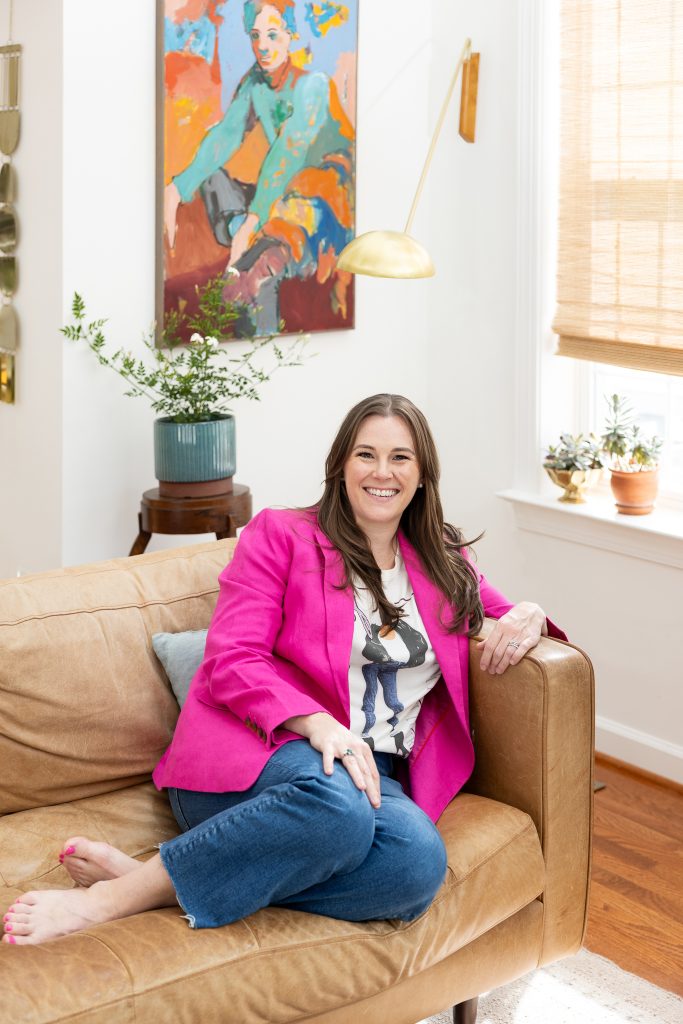
Jess Harrell
Jess Harrell grew up in Frederick but has lived in Northern Virginia “except for one epic year in my 20s living in DC with my best friends” since she left home to attend George Mason University. Having resided in Fairfax, Vienna, and Falls Church, the interior designer is now living with her husband and kids in Purcellville. Follow her for a dose of humor and lots of “colorful and personality-packed interior design.”
What do you do for a living?
I’m an interior designer with a background in psychology. I work with people who want their homes to celebrate who they are, speak their language, and make them feel alive inside. I take a very personal approach and dig deep to learn my clients’ personalities, quirks, and what’s meaningful to them. When your home truly feels like you, it becomes a place where you don’t just live—you thrive. Interior design is really just self-care to me.
What are some of your go-to DMV spots?
The Lucketts Store (and their spring and fall Markets) is my favorite place to shop for vintage and antiques. Mom’s Apple Pie in Leesburg is my go-to for a special dessert. My husband and kids always want their Boston Cream Pie for their birthday cakes. The Riggs Hotel is my favorite spot for a night in DC. It’s in the old Riggs National Bank building, and the original architectural features give it so much character. The restaurant bar is the real star, though. It’s chic and sophisticated, and the furniture is super loungeable. It’s very hard to leave! I always try to stop at The Italian Store if I’m in the Arlington area. I crave their subs!
What are some of your go-to DMV spots?
I’m slightly biased since I grew up there, but downtown Frederick is very underrated. It’s grown a lot since I was a kid, but it’s still just as charming. You could spend a whole day there checking out all the cute shops, eating good food, and walking along Carroll Creek Park.
What’s your go-to spot to bring visitors?
I love taking visitors to hike up to Bear’s Den Overlook. The view of the Shenandoah Valley is incredible. If they weren’t impressed with that view, I’d take them to Dirt Farm or Bear Chase for beer and wine with a view of the Loudoun Valley. Rumor has it that you can see the Washington Monument with binoculars, but I’ve never tried.
What’s your favorite meal in the DMV?
Dinner at Rose’s Luxury in Southeast DC was hands down the best meal of my life. The pork and lychee salad is unbelievable. And I’ll always remember the Brooklyn-style cheesecake at Caruso’s Grocery (also in SE). So, so good.

Sarah Lyon is a New York City-based freelance writer, originally from Bethesda, MD. She contributes to a number of national design and lifestyle publications like Architectural Digest, Apartment Therapy, MyDomaine, the Washington Post, and more. Sarah also works with designers to help them style spaces for photo shoots. Find more shelfies on her Instagram page, @sarahlyon9
Don’t miss a post! Get the latest local guides and neighborhood news straight to your inbox!

 Facebook
Facebook
 X
X
 Pinterest
Pinterest
 Copy Link
Copy Link













